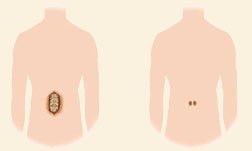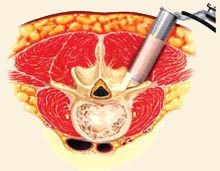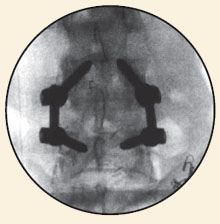TLIF – Transforaminal Lumbar Interbody Fusion
A transforaminal lumbar interbody fusion (TLIF) is a type of spine surgery that involves approaching the spine from the back, or posterior, of the body to place bone graft between two vertebrae. The procedure may be performed using minimally invasive surgical techniques.
What Is A Minimally Invasive TLIF?
Transforaminal lumbar interbody fusion (TLIF) is a form of spine surgery in which the lumbar spine is approached through an incision in the back. The name of the procedure is derived from: transforaminal (through the foramen), lumbar (lower back), interbody (implants or bone graft placed between two vertebral bodies) and fusion (spinal stabilization).
The TLIF is a variation of the posterior lumbar interbody fusion (PLIF), in that it provides 360-degree fusion, avoids anterior access and associated complications, decreases manipulation of neural structures, reduces damage to ligamentous elements, minimizes excessive bone removal, enhances biomechanical stability, and provides early mobilization.
Traditional, open spine surgery involves cutting or stripping the muscles from the spine. But today, a TLIF may be performed using minimally invasive spine surgery, a treatment that involves small incisions and muscle dilation, allowing the surgeon to gently separate the muscles surrounding the spine rather than cutting them. A minimally invasive approach preserves the surrounding muscular and vascular function and minimizes scarring.
Why Do I Need This Procedure?
A spinal fusion procedure such as a TLIF may be recommended as a surgical treatment option for patients with a condition causing spinal instability in their lower back, such as degenerative disc disease, spondylolisthesis or spinal stenosis, which has not responded to conservative treatment measures (rest, physical therapy or medication). The symptoms of lumbar spinal instability may include pain, numbness and/or muscle weakness in the low back, hips and legs.
Your surgeon will take a number of factors into consideration before recommending a TLIF, including the condition to be treated, your age, health and lifestyle and your anticipated level of activity following surgery. Please discuss this treatment option thoroughly with your spinal care provider.

How Is A Minimally Invasive TLIF Performed?
Spinal Access and Bone Removal
First, your surgeon will make a small incision in the skin of your back over the vertebra(e) to be treated. Depending on the instrumentation to be used, the incision could be as small as approximately 3 centimeters. In a traditional open TLIF, a 3- to 6-inch incision is typically required.

The muscles surrounding the spine will then be dilated to allow access to the section of spine to be stabilized. After the spine is accessed, the lamina (the “roof” of the vertebra) is removed to allow visualization of the nerve roots. The facet joints, which are directly over the nerve roots, may be trimmed to give the nerve roots more room.
Bone Graft Material Placement
The nerve roots are then moved to one side and the disc material removed from the front (anterior) of the spine. A bone graft is then inserted into the disc space. The bone graft material acts as a bridge, or scaffold, on which new bone can grow. Screws and rods are inserted to stabilize the spine while the treated area heals and fusion occurs, and the ultimate goal of the procedure is to restore spinal stability.

Your surgeon will then close the incision, which typically leaves behind only a small scar or scars.
How Long Will It Take Me To Recover?
This minimally invasive procedure typically allows many patients to be discharged the day after surgery; however, some patients may require a longer hospital stay. Many patients will notice immediate improvement of some or all of their symptoms; however, other symptoms may improve more gradually.

A positive attitude, reasonable expectations and compliance with your doctor’s post-surgery instructions all may contribute to a satisfactory outcome. Many patients are able to return to their regular activities within several weeks.
To determine whether you are a candidate for minimally invasive surgery, talk to your doctor.
Are There Any Potential Risks Or Complications?
All treatment and outcome results are specific to the individual patient. Results may vary. Complications such as infection, nerve damage, blood clots, blood loss and bowel and bladder problems, along with complications associated with anesthesia, are some of the potential risks of spinal surgery. A potential risk inherent to spinal fusion is failure of the vertebral bone and graft to properly fuse, a condition that may require additional surgery.

Please consult your physician for a complete list of indications, warnings, precautions, adverse effects, clinical results and other important medical information that pertains to a minimally invasive TLIF procedure.
- Stevens KJ, Spenciner DB, Griffiths KL, Kim KD, Zwienenberg-Lee M, Alamin T, Bammer R. Comparison of minimally invasive and conventional open posterolateral lumbar fusion using magnetic resonance imaging and retraction pressure studies. J Spinal Disord Tech. 2006 Apr;19(2):77-86
- Khoo LT, Fessler RG. Microendoscopic decompressive laminotomy for the treatment of lumbar stenosis. Neurosurgery. 2002 Nov;51(5 Suppl):S146-54
The materials on this Web site are for your general educational information only. Information you read on this Web site cannot replace the relationship that you have with your health care professional. We do not practice medicine or provide medical services or advice as a part of this Web site. You should always talk to your health care professional for diagnosis and treatment.
 Menu
Menu








